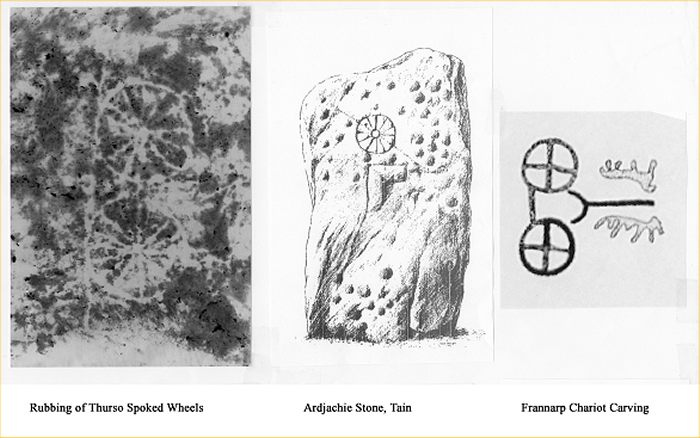|
Thurso �Spoked Wheels� Stone (by Geoff Leet)
The Stone
Opposite 14 St Andrews Drive, Thurso, at ND 1143 6758, west of the road
fence in the shadow of a tree, lies a stone about 1.2 M long and 0.7M wide
with 0.3M showing above the ground. To one side of the rough top face are
inscribed two spoked wheels with rough markings above, and were noticed by
Sinclair Houston in 1925 when this was a green field. Each wheel has about
12 spokes. The wheels look like perfect 8 cm diameter circles but actually
vary from 79 to 83 mm in one and 77 to 81 mm in the other so are clearly
hand inscribed without mechanical assistance. George Watson's rubbing of
the stone is reproduced here, and the probable date of the inscription is
discussed below.
A Modern Bicycle Wheel?
Starley's ROVER safety bicycle with chain drive and equal sized wheels
brought in the modern bicycle in 1885, so this would appear to be the
earliest model available to a bicycle artist. The two wheels on the stone
are too close together to correctly depict a bicycle. If a bicycle has
been portrayed the date of carving must probably lie between 1885 and
1925.
A Pictish Symbol Stone?
Wheels are very rare in Pictish art. A two horse, two wheel cart, carrying
a driver with two passengers under a roof, appeared on Meigle No 10 in
Perthshire, now lost. It was a conventional side view and the wheel is 12
spoked. It may be a Biblical scene.
At Alyth, also in Perthshire, a surviving part of a double disk is
decorated by 15 radial lines from an offset hub. (Ref 1)

Chariot Wheels?
Carvings at Frannarp, south Sweeden, 1500-1300BC, showed several chariots
depicted from above with the chassis as it would appear in an aerial
photograph, but with the wheels and the horses laid flat on the ground
alongside. One chariot is reproduced here, and the wheel placing is
similar to the Thurso stone.
These wheels were the 4 spoke light bentwood and rawhide Ancient Egyptian
type. These could be made without metal but could not survive well in damp
northern Europe where wheels like light cart wheels came to be favoured.
(Ref 2). The Romans invading Britain were surprised to be attacked by
chariots that had fallen out of use elswhere.
Another Spoked Wheel Stone
Outside Tain Museum stands the Ardjachie Stone with cup marks (probably
Bronze Age), an "L" shape, and a single 12 spoke wheel reproduced here.
The features may not be of the same date and Picts have been known to
reuse existing stones. (Ref 3)
References
1. The Art of the Picts by George & IsobelHenderson, page 220.
2. British Archaeology, Sept/Oct 2005, page 41
3. Pictish Stones of Easter Ross by Ellen MacNamara, page 13. |











